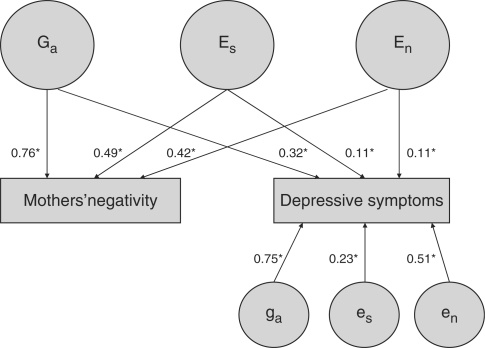Figure 2.
A reprinted figure from the first full multivariate genetic analysis between an environmental measure (mothers’ negativity) and an outcome measure (their adolescent children’s depressive symptoms). (Source: Adapted with permission from Pike et al.58 published by the American Psychological Association).86 Asterisks denote loadings significant at P < 0.05. The latent variables Ga, Es and En represent a genetic factor, a shared environmental factor and a non-shared environmental factor, respectively, that affect the environmental measure (mothers’ negativity) and also affect the outcome measure (adolescent children’s depressive symptoms). The latent variables ga, es and en represent the genetic, shared environmental and non-shared environmental influences, respectively, that are unique to the outcome measure. The path coefficients indicate how the variance of depressive symptoms can be attributed to genetic and environmental components of variance that covary or do not covary with mothers’ negativity. Because the path coefficients are standardized, squaring them indicates the proportion of variance explained by a path. Thus, squaring and summing the six path coefficients leading to depressive symptoms yields 1.0, the total variance of the depressive symptoms measure. Squaring the significant common non-shared environment path of 0.11 indicates that non-shared environmental influences that covary with mothers’ negativity explain only 1.2% of the variance of depressive symptoms. However, the product of the non-shared environmental paths connecting mothers’ negativity and depressive symptoms (i.e. 0.42 × 0.11 = 0.046) indicates that non-shared environmental influences contribute 0.046 to the phenotypic correlation between them. The phenotypic correlation is 0.33, which means that non-shared environment explains 14% of the correlation between mothers’ negativity and depressive symptoms (i.e. 0.046/0.330 = 0.139). The significance of the residual en parameter indicates that there are significant non-shared environmental effects on depressive symptoms that are not explained by non-shared environmental effects due to mothers’ negativity. Squaring the en path coefficient of 0.51 indicates that 26% of the variance of depressive symptoms is due to such residual non-shared environmental influences, which includes error of measurement. Thus, non-shared environmental influences on mothers’ negativity explains 4.6% of the total non-shared environmental variance (including error of measurement) of depressive symptoms (i.e. 0.112/0.512 = 0.012/0.260 = 0.046)

